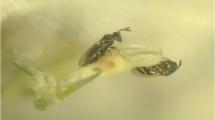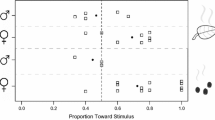Abstract
We investigated signal sources used by the parasitoid Lemophagus pulcher in locating and accepting larvae of its host, the lily leaf beetle, Lilioceris lilii. Olfactometer bioassays revealed that larvae with fecal shields, larvae without shields, the shield alone, and lily leaves damaged by L. lilii were all attractive to female parasitoids. In contact bioassays, L. pulcher females were attracted to shields and showed ovipositor probing independently of whether the larva underneath was L. lilii or a nonhost, suggesting that the shield plays a primary role in short-range host location and host acceptance by L. pulcher. The attractiveness of the shield is at least partly of a chemical nature, since shield extracts applied to dummies increased contact duration and induced ovipositor probing by L. pulcher. Another putative defense system of L. lilii, i.e., oral discharge which is emitted by disturbed larvae, was also attractive to experienced, but not to naive, female parasitoids. In all other tests, naive and experienced female L. pulcher responded to the same signal sources tested, suggesting that the host-selection behavior of this biological control candidate is governed largely by innate responses to host-associated cues.
Similar content being viewed by others
REFERENCES
Bernays, E. A., and Chapman, R. F. (1994). Host-Plant Selection by Phytophagous Insects, Chapman and Hall, New York.
de Moraes, C. M., Lewis, W. J., Pare, P. W., Alborn, H. T., and Tumlinson, J. H. (1998). Herbivoreinfested plants selectively attract parasitoids. Nature 393: 570-573.
Dicke, M., and Vet, L. E. M. (1999). Plant-carnivore interactions: Evolutionary and ecological consequences for plant, herbivore and carnivore. In Olff, H., Brown, V. K., and Drent, R. H. (eds.), Herbivores: Between Plants and Predators, Proceedings of 38th Symposium of British Ecological Society, Blackwell, London, pp. 483-520.
Dicke, M., Takabayashi, J., Posthumus, M. A., Schütte, C., and Krips, O. E. (1998). Plantphytoseiid interactions mediated by herbivore-induced plant volatiles:Variation in production of cues and in responses of predatory mites. Review. Exp. Appl. Acarol. 22: 311-333.
Eisner, T., Tassel, E. V., and Carrel, J. E. (1967). Defensive use of a “fecal shield” by a beetle larva. Science 158: 1471-1473.
Godfray, H. C. J. (1994). Parasitoids: Behavioural and Evolutionary Ecology, Princeton University Press, Princeton, NJ.
Gomez, N. E. (1997). The Fecal Shields of Larvae of Tortoise Beetles (Cassidinae: Chrysomelidae): A Role in Chemical Defense Using Plant-Derived Secondary Compounds, Dissertation, Technische Universitaet Carolo-Wilhelmina Braunschweig.
Gomez, N. E., Witte, L., and Hartmann, T. (1999). Chemical defense in larval tortoise beetles: Essential oil composition of fecal shields of Eurypedus nigrosignata and foliage of its hostplant, Cordia currasavica. J. Chem. Ecol. 25: 1007-1027.
Haye, T. (2000). Oekologische Studien zum Parasitoidenkomplex von Lilioceris lilii (Scop.) (Col.: Chrysomelidae) an ausgewaehlten mitteleuropaeischen Standorten. M.S. thesis, University of Kiel, Kiel.
Jaenike, J., and Papaj, D. R. (1992). Learning and patterns of host use in insects. In Roitberg, B. D., and Isman, M. (eds.), Chemical Ecology: Ecological and Evolutionary Perspectives, Chapman and Hall, New York, pp. 245-264.
Kenis, M., Haye, T., Casagrande, R. A., Gold, M. S., and Tewksbury, L. (2000). Biological control of the lily leaf beetle, Lilioceris lilii, in North America, using parasitoids from Europe. Mitteilungen aus der Biologischen Bundesanstalt für Land-und Forstwirtschaft, Berlin-Dalhem 370, p. 292.
Lewis, W. J., and Tumlinson, J. H. (1988). Host detection by chemically mediated associative learning in a parasitic wasp. Nature 331: 257-259.
Lewis, W. J., Jones, R. L., and Redlinger, L. J. (1971). Moth odour: A method of host-finding by Trichogramma evanescens. J. Econ. Entomol. 64: 557-558.
Mattiacci, L., and Dicke, M. (1995). The parasitoid Cotesia glomerata (Hym.: Braconidae) discriminates between first and fifth larval instars of its host Pieris brassicae, on the basis of contact cues from frass, silk, and herbivore-damaged leaf tissue. J. Insect Behav. 8: 485-498.
Meiners, T., Westerhaus, C., and Hilker, M. (2000). Specificity of chemical cues used by a specialist egg parasitoid during host location. Entomol. Exp. Appl. 95: 151-159.
Morton, T. C., and Vencl, F. V. (1998). Larval beetles form a defense from recycled host-plant chemicals discharged as fecal wastes. J. Chem. Ecol. 24: 765-785.
Müller, C. (1999). Chemische Ökologie des Phytophagenkomplexes an Tanacetum vulgare L. (Asteraceae), Dissertation, Freie Universitaet Berlin, Logos-Verlag.
Müller, C., and Hilker, M. (1999). Unexpected reactions of a generalist predator towards defensive devices of cassidine larvae (Col., Chrysomelidae). Oecologia 118: 166-172.
Noldus, L. P. J. J. (1989). Chemical Espionage by Parasitic Wasps: How Trichogramma Species Exploit Moth Sex Pheromone Systems, Ph.D. dissertation, Agricultural University, Wageningen, The Netherlands.
Olmstead, K. L. (1994). Waste products as chrysomelid defences. In Jolivet, P. H., Cox, M. L., and Petitpierre, E. (eds.), Novel Aspects of the Biology of Chrysomelidae, Kluwer Academic, Dordrecht, pp. 311-318.
Olmstead, K. L., and Denno, R. F. (1992). Cost of shield defence for tortoise beetles (Col.: Chrysomelidae). Ecol. Entomol. 17: 237-243.
Olmstead, K. L., and Denno, R. F. (1993). Effectiveness of tortoise beetle larval shields against different predator species. Ecology 74: 1394-1405.
Pasteels, J. M., Braekman, J. C., and Daloze, D. (1988). Chemical defense in the Chrysomelidae. In Jolivet, P., Petitpierre, E., and Hsiao, T. H. (eds.), Biology of Chrysomelidae, Kluwer Academic, Dordrecht, pp. 231-250.
Powell, W., Pennachio, F., Poppy, G. M., and Tremblay, E. (1998). Strategies involved in the location of hosts by the parasitoid Aphidius ervi Haliday (Hym.: Braconidae: Aphidiinae). Biol. Control 11: 104-112.
Quicke, D. J. L. (1997). Parasitic Wasps, Chapman and Hall, London.
Root, R. B., and Messina, F. J. (1983). Defensive adaptations and natural enemies of a casebearing beetle, Exema canadensis (Col.: Chrysomelidae). Psyche 90: 67-80.
Schmitt, M. (1988). The Criocerinae: Biology, phylogeny and evolution. In Jolivet, P., Petitpierre, E., and Hsiao, T. H. (eds.), Biology of Chrysomelidae, Kluwer Academic, Dordrecht, pp. 475-495.
Schoonhoven, L. M., Jermy, T., and van Loon, J. J. A. (1998). Insect-Plant Biology: From Physiology to Evolution, Chapman and Hall, London.
Steidle, J. L. M. (2000). Host recognition cues of the granary weevil parasitoid Lariophagus distinguendus. Entomol. Exp. Appl. 95: 185-192.
Steidle, J. L. M., and Schöller, M. (1997). Olfactory host location and learning in the granary weevil parasitoid Lariophagus distinguendus (Hymenoptera, Pteromalidae). J. Insect Behav. 10: 331-342.
Steinhausen, W. (1950). Vergleichende Morphologie, Biologie und Oekologie der Entwicklungsstadien der in Niedersachsen heimischen Schildkaefer (Cassidinae, Chrysomelidae, Coleoptera) und deren Bedeutung fuer die Landwirtschaft, Dissertation, Technische Hochschule Carolo-Wilhelmina Braunschweig.
Tumlinson, J. H., Turlings, T. C. J., and Lewis, W. J. (1992). The semiochemical complexes that mediate insect parasitoid foraging. Agr. Zool. Rev. 5: 221-252.
Turlings, T.C. J., Waeckers, F. L., Vet, L. E. M., Lewis, W. J., and Tumlinson, J. H. (1993). Learning of host-location cues by hymenopterous parasitoids. In Lewis, A. C., and Papaj, D. R. (eds.), Insect Learning: Ecological and Evolutionary Perspectives, Chapman and Hall, New York, pp. 51-78.
Vencl, F. V., and Morton, T. C. (1998). The shield defence of the sumac flea beetle, Blepharida rhois (Chrysomelidae, Alticinae). Chemoecology 8: 25-32.
Vencl, F. V., Morton, T. C., Mumma, R. O., and Schultz, J. C. (1999). Shield defence of a larval tortoise beetle, J. Chem. Ecol. 25: 549-566.
Weise, J. (1893). Naturgeschichte Insekten Deutschlands. In Erichson, W. F. (ed.), Coleoptera, Chrysomelidae, Vol. 6, Berlin.
Wellso, S. G., and Hoxie, R. P. (1988). Biology of Oulema. In Jolivet, P., Petitpierre, E., and Hsiao, T. H. (eds.), Biology of Chrysomelidae, Kluwer Academic, Dordrecht, pp. 497-511.
Author information
Authors and Affiliations
Corresponding author
Rights and permissions
About this article
Cite this article
Schaffner, U., Müller, C. Exploitation of the Fecal Shield of the Lily Leaf Beetle, Lilioceris lilii (Coleoptera: Chrysomelidae), by the Specialist Parasitoid Lemophagus pulcher (Hymenoptera: Ichneumonidae). Journal of Insect Behavior 14, 739–757 (2001). https://doi.org/10.1023/A:1013085316606
Issue Date:
DOI: https://doi.org/10.1023/A:1013085316606




